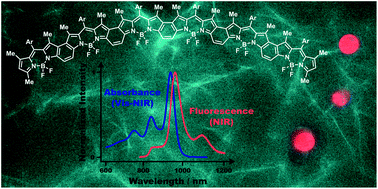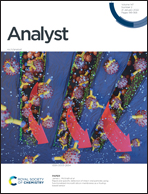NIR-emitting benzene-fused oligo-BODIPYs for bioimaging†
Abstract
Near-infrared (NIR) fluorophores are emerging tools for biophotonics because of their reduced scattering, increased tissue penetration and low phototoxicity. However, the library of NIR fluorophores is still limited. Here, we report the NIR fluorescence of two benzene-fused oligo-BODIPYs in their hexameric (H) and octameric (O) forms. These dyes emit bright NIR fluorescence (H: maxima 943/1075 nm, O: maxima 976/1115 nm) that can be excited in the NIR (H = 921 nm, O = 956 nm) or non-resonantly over a broad range in the visible region. The emission bands of H show a bathochromic shift and peak sharpening with increasing dye concentration. Furthermore, the emission maxima of both H and O shift up to 20 nm in solvents of different polarity. These dyes can be used as NIR ink and imaged remotely on the macroscopic level with a stand-off distance of 20 cm. We furthermore demonstrate their versatility for biophotonics by coating microscale beads and performing microrheology via NIR video particle tracking (NIR-VPT) in biopolymer (F-actin) networks. No photodamaging of the actin filaments takes place, which is typically observed for visible fluorophores and highlights the advantages of these NIR dyes.

- This article is part of the themed collection: Analyst HOT Articles 2021


 Please wait while we load your content...
Please wait while we load your content...